Go to Ohio bird tour page | USA bird tours | North American trip reports | All our birding tours
09-12 May 2022
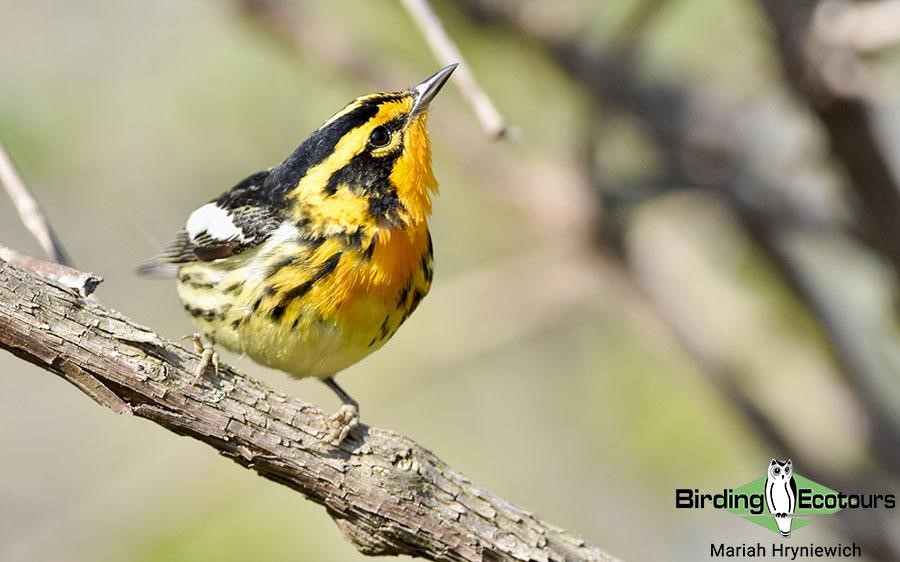
Overview
This four-day tour of Ohio began in Delaware and moved north, eventually taking a flight home from Detroit. We explored some of the most well-known birding locations in the country, such as Magee Marsh, Oak Openings and Ottawa National Wildlife Refuge. We also enjoyed birds at a couple of smaller parks and nature preserves along the way.
During these four days we laid our eyes on some of the most fantastic birds and heard their beautiful voices singing throughout the woods. Some of the main highlights for this couple were Trumpeter Swan, Eastern Whip-poor-will, Virginia Rail, Sora, a variety of shorebirds, Red-headed and Hairy Woodpeckers, White-breasted and Red-breasted Nuthatches and Orchard Oriole. The stars of this trip were of course the diversity of warblers in their breeding plumage during spring migration!
A total of 107 bird species were seen, along with different animals, including Eastern Chipmunk and two different snakes (Black Racer and Ribbon Snake), as well as turtles and bumblebees. Our full bird and animal checklists can be found at the end of the report.
Detailed Report
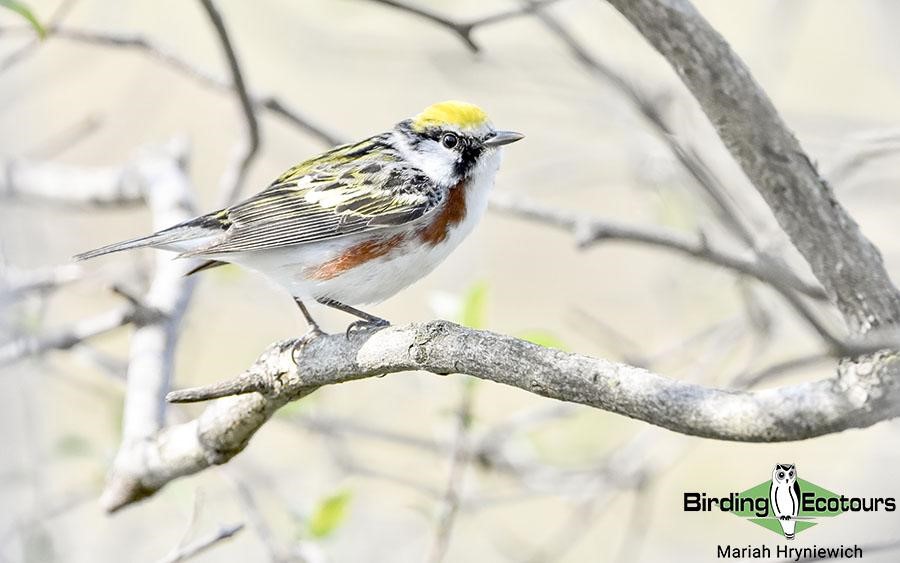
Day 1, 9th May 2022. Arrival in Delaware and birding north
On the first day of the tour, I picked the couple up around 11 am in Delaware, Ohio. To have a break in our couple of hour journey north, we stopped at Wintergarden Woods and Saint John’s Nature Preserve. This was an amazing spot with a short boardwalk, feeders and perfect habitat all around. Here we had incredible looks at a Wood Thrush singing just five feet in front of us on the path. Warblers greeted us in flocks, with Black-and-white, Nashville, Magnolia, Bay-breasted, Chestnut-sided, Black-throated Blue, Black-throated Green and Yellow-rumped Warblers and American Redstart. We got our first look of many White-breasted Nuthatches traveling up and down a nearby Oak. A Cooper’s Hawk swooped over us in the parking lot, probably looking for its next meal.
After a great start, we had a delicious lunch with Chimney Swift flying overhead! We decided to check into the hotel and drop off luggage before going to Magee Marsh. Later in the evening the journey started to the long-awaited Magee! Excited to be there, we headed straight for the boardwalk. The “sweet-sweet-sweet” song of Yellow Warbler was heard until the sun went down. A main target for many, a male Blackburnian Warbler perched ten feet in front of us. Wow, what great views and a stunner he was! For the next two hours Black-capped Chickadee, Ruby-crowned Kinglet, Baltimore Oriole and Rose-breasted Grosbeak covered the trees and became our welcoming committee. Before finishing the walk, a Black Racer was spotted just a foot off the boardwalk. Always a nice addition as it is only common in the east. Exhausted from travel, we went back to the hotel, but not before meeting a Snapping Turtle! Usually, it is the Canada Geese holding up traffic, but not this time. On the way out this turtle was trying to cross the road and wanted everyone to know. Next stop was dinner, to talk and fill our bellies!
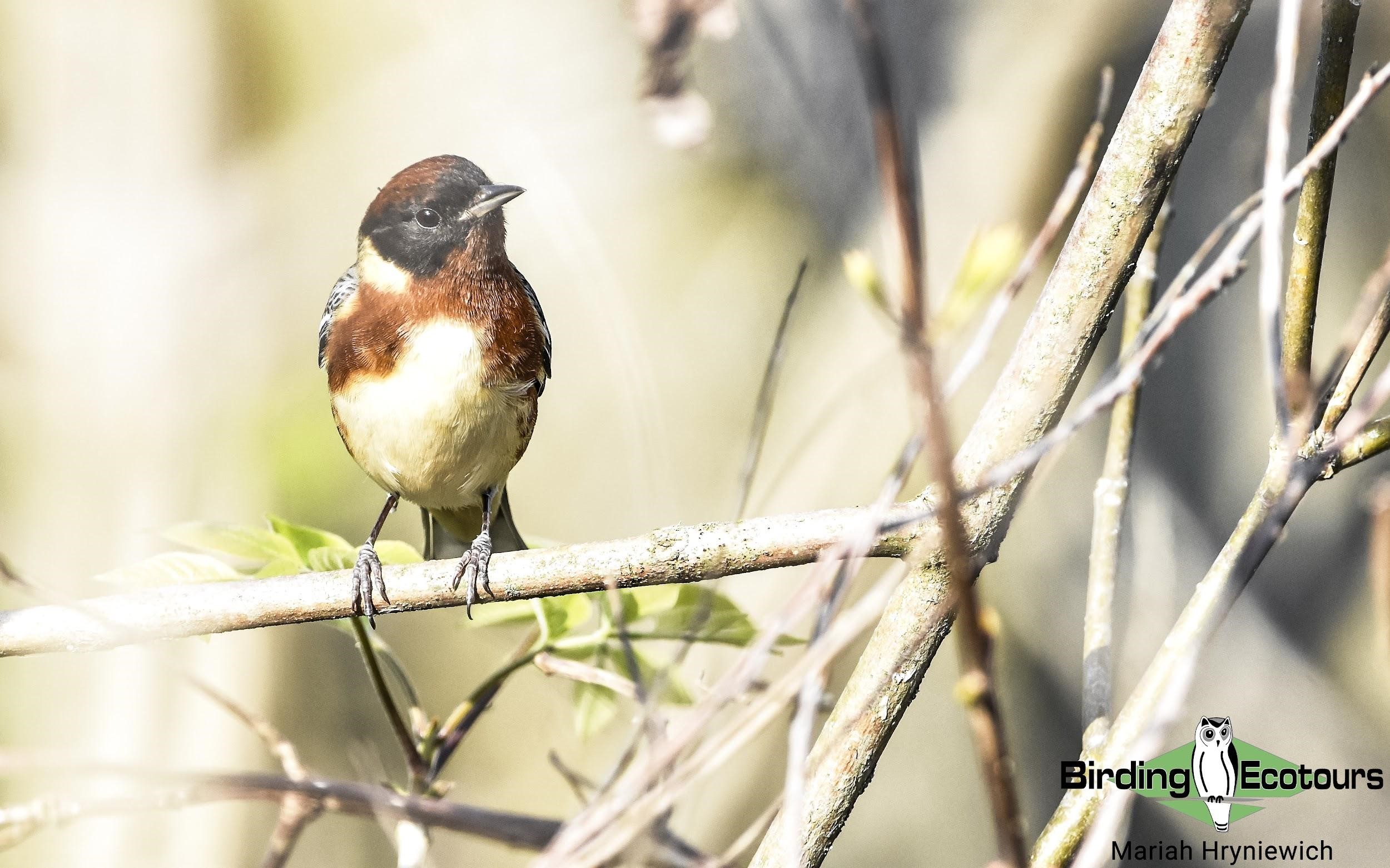
Day 2, 10th May 2022. Wintergarden Woods, Magee Marsh and Oak Openings
Wintergarden Woods and Saint John’s Nature Preserve had been so excellent the previous day that we decided we had to go back! At this time of the year, birds are on a long migration journey and anything can stop overnight for rest or food. As soon as we got out of the car, we were bombarded by warblers doing just that. Magnolia Warblers were chasing each other, American Redstart was mixed in with Common Yellowthroat, while Black-and-white Warbler scurried up and down the tree trunks and Chestnut-sided Warbler stayed high in the treetops. Scarlet Tanagers continuously called back and forth to each other, making their presence known. Swainson’s and Wood Thrushes gave us a fantastic comparison, being just four feet from each other and taking turns singing. We walked on the boardwalk over the pond and Mel spotted a Least Flycatcher high in the leafless trees. There were feeders here that brought American Goldfinch, Brown-headed Cowbird, Tufted Titmouse and House Wren looking to fatten up. Again, our friend from yesterday, the Cooper’s Hawk was in the parking lot. We talked to the passionate manager of the preserve and he said this hawk had been there for days. Definitely worth the return visit!
Leaving the preserve, we ventured to the largest metropark, Oak Openings, at over 5,000 acres. It is a huge preserve offering over 70 miles of trails for hikers, horses, skiers, mountain bikers, camping for people of all ages and much more. We raced to the lodge area first after being told there was a Mourning Warbler! Lifer for all! He was jumping around in some dense brush near the bridge that overlooked the river. Birds always find the water! In this same little area we saw Prothonotary Warbler, Magnolia Warbler, American Redstart, Chestnut-sided Warbler, Rose-breasted Grosbeak and Baltimore Oriole. Not too far from the lodge was a center with ‘Windows on Wildlife’. This was the perfect spot for a little break. We watched birds on feeders from the comfort of an air-conditioned room. White-breasted Nuthatch, Chipping Sparrow, Brown-headed Cowbird and Black-capped Chickadee were just on the other side of the glass, not knowing people were there just for them. Of course, Red-bellied and Downy Woodpeckers had to get in on some free food action! Having this experience allowed us to view these bird’s details in a way that may not have been possible otherwise.
It had been an eventful day thus far, so we stopped for some lunch and continued on our way north for some more Magee Marsh! The boardwalk is quite lengthy, especially with the “shortcut” barricaded due to some trees knocked over during a storm, but we took our time and enjoyed 55 species! It was difficult to choose the best one, with so many incredible birds, but Eastern Whip-poor-will was at the top of the list! We got to see this nocturnal nightjar perched in the daytime two feet away! It was not bothered one bit by the dozens of people stopping to stare. We heard and saw seven species of flycatcher! These included Yellow-bellied, Acadian, Willow, Least, Great Crested Flycatcher, Eastern Wood-Pewee and Eastern Phoebe, some of which were lifers! With almost every step we heard Warbling Vireo singing, but we didn’t mind. They had lovely voices. About halfway there, tucked away in one of the fallen trees, a Ribbon Snake lay very well camouflaged with its surroundings. Magee Marsh was a safe haven for so many species. Hopping around in the dense brush and dead leaves strewn on the ground, we saw the unmistakable White-crowned and White-throated Sparrows one of the most common Song Sparrow and the similar Lincoln’s Sparrow. The “Warbler Capital of the World” (Magee Marsh) continued to live up to its name, with us spotting 15 species in such a short space of time! Some of the highlights in this group were Magnolia, Bay-breasted, Blackburnian, Chestnut-sided and Nashville Warblers and Northern Waterthrush! Birds were everywhere, it was inevitable. Baltimore Oriole flashed bright orange when jumping from tree to tree, Sandhill Cranes sounded like real-life dinosaurs from high in the sky and Red-winged Blackbird flew across the marsh with Northern Cardinal. Not wanting to leave, we headed back to the car as the sun set. Our first full day together had been a great success! We enjoyed a delicious Lebanese dinner and much-needed rest.
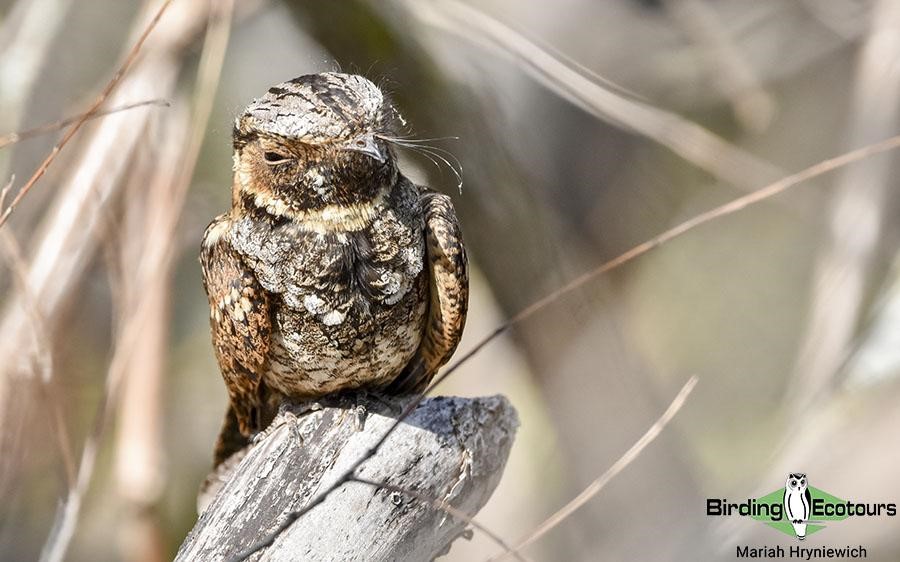
Day 3, 11th May 2022. More to see at Magee Marsh and Oak Openings
Magee Marsh is over 2,000 acres and Oak Openings is nearly 5,000 acres of land. These areas are huge, making it impossible to see everything in one day. After breakfast we set off to our new favorite boardwalk. As we pulled into the parking lot of Magee, we watched 150 Blue Jays over our heads! It was truly fascinating to see this huge flock migrating together like this. Before beginning our walk, we took a peep at the Bald Eagles that had built their nest in the parking area. The park management had barricaded this area off so cars could not drive underneath or park nearby, giving these eagles their space with minimal disturbance. It worked because these parents had three babies to care for! At the start of our walk, we watched a Downy Woodpecker make sure his tree hole was perfect for a nest, while Tree Swallows flew in and out of the dozens of other holes in the trees. A flash of red, but not cardinal red, revealed Scarlet Tanager! It was like Christmas morning, seeing that vibrant red against the brown branches, still bare of leaves. We thought 15 species of warblers were fantastic yesterday, but today we added to it for a total of 18! Some of these we had already seen, but that didn’t matter. We never got tired of these adorable yet fierce jewels of warblers. The Wilson’s Warbler migrates through, just like many of the others, from South America to reach its breeding grounds in the far north. Easily confused with the Black-and-white Warbler, the Blackpoll Warbler is only seen in half of the United States. A handsome male came out from behind some branches when he heard that some of us were from California. Along with these we got incredible views of Tennessee Warbler, Cape May Warbler, Northern Parula and Palm Warbler, with its distinctive pumping of its tail. Perhaps the best experience on the boardwalk on this day was Prothonotary Warbler. Just inches away from us, this bright yellow bird with blue-grey wings started scurrying all over a fallen trunk. It was so close Mel was able to record it with her cell phone! Knowing this bird is one of two warblers which nest in cavities, we assumed it was looking for a potential home. Although this was a long boardwalk, it had many benches spaced out for a rest when needed. The second half surprised us with an Orchard Oriole. Another lifer! These birds come to the United States to breed but don’t go very far west.
We simply had to check the shore of one of the Great Lakes before leaving! Flying over Lake Erie we saw Ring-billed Gull and American White Pelican. We saw Great Blue Heron standing knee-deep and as still as statues, hunting their next meal. Driving out of the marsh was beautiful and we saw Blue-winged Teal, Wood Duck and Pied-billed Grebe, many with young babies, just outside of our windows.
Near Magee is another famous spot, well-known by birders: Blackberry Corners, a local restaurant that is a staple in this community. A slice of Brenda Lowe’s scratch-made Lifer Pie is the perfect celebration, whether you have seen a life bird or not. We enjoyed a delicious lunch here – definitely not to be missed!
Another trip to Oak Openings was needed. During our first five minutes we saw three Red-headed Woodpeckers and one Hairy Woodpecker! In the distance we heard American Crows calling back and forth. We continued walking over the bridge and into the fields and saw a small, pink billed sparrow flying between pieces of tall grass, none other than Field Sparrow! Simultaneously, we heard Virginia Rails, which surprised us by peeking their heads out just a couple feet to the right. Wanting to sit, rest and enjoy birds for a while, we went to feeders nearby. With water flowing and feeders full, Brown-headed Cowbird, Red-bellied Woodpecker and Mourning Dove couldn’t resist. Neither could Eastern Chipmunk! We got as close as we ever possibly could to adorable Chipping Sparrow. Surrounding the feeders were big, beautiful oak trees with Rose-breasted Grosbeak and American Robin. After an exciting day out, we were ready for dinner.
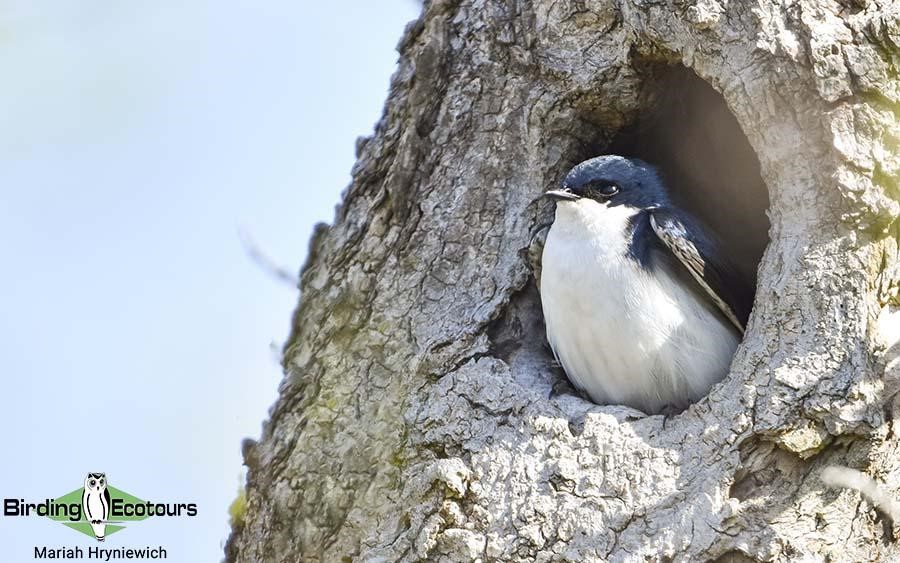
Day 4, 12th May 2022. Last outing and departure
We didn’t want to get too tired before sitting on a plane, so Ottawa National Wildlife Refuge was perfect for the last day. We stepped into their Visitor Center to get souvenirs and saw Ruby-throated Hummingbird slurping sugar water outside. We spent the remainder of our time doing a wildlife drive and saw 44 species on this seven-mile route! One spot was perfect for shorebirds and hundreds of Dunlins thought so too. Joining them were Least Sandpiper, Lesser Yellowlegs, Killdeer and Semipalmated Plover. Trumpeter Swans were abundant and these huge white birds seemed to be within arm’s reach outside the car. Brilliantly-colored Indigo Bunting gave us beautiful views, landing in front of us and in nearby trees. We heard chatter coming from the cattails and Marsh Wrens popped up! In this area we were able to see five in total. As the day got hotter and we neared the end, Red-tailed Hawk began soaring above. On the way to the airport, we made one last stop to visit Pearson Metropark. Carolina Wrens and their nest of babies were hiding in the corner of a pavilion! Visiting the feeders were White-breasted Nuthatch, American Redstart and Yellow Warbler. As we walked to the car, we saw Pileated Woodpecker.
After a wonderful morning of birding in Ohio, it was now time to go to the airport. Exploring many new places, seeing a plethora of birds, making new friends and tons of memories, this long-awaited trip was definitely one we wouldn’t forget!
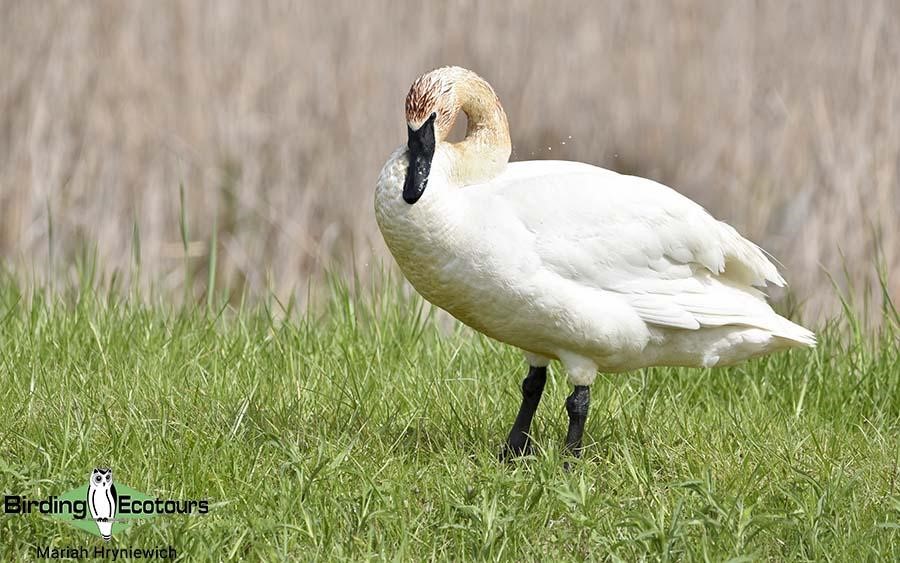
Bird List – Following IOC (12.1)
Birds ‘heard only’ are marked with (H) after the common name, all other species were seen. Species seen only on the pre-trip day of this trip are marked with (+) after the common name.
The following notation after species names is used to show conservation status following BirdLife International: CE = Critically Endangered, EN = Endangered, VU = Vulnerable, NT = Near Threatened.
| Common Name | Scientific Name |
| Ducks, Geese, Swans (Anatidae) | |
| Canada Goose | Branta canadensis |
| Trumpeter Swan | Cygnus buccinator |
| Wood Duck | Aix sponsa |
| Blue-winged Teal | Spatula discors |
| Mallard | Anas platyrhynchos |
| Nightjars (Caprimulgidae) | |
| Eastern Whip-poor-will | Antrostomus vociferus |
| Swifts (Apodidae) | |
| Chimney Swift – VU | Chaetura pelagica |
| Hummingbirds (Trochilidae) | |
| Ruby-throated Hummingbird | Archilochus colubris |
| Pigeons, Doves (Columbidae) | |
| Rock Dove (Introduced) | Columba livia |
| Mourning Dove | Zenaida macroura |
| Rails, Crakes & Coots (Rallidae) | |
| Virginia Rail | Rallus limicola |
| Sora | Porzana carolina |
| Common Gallinule | Gallinula galeata |
| American Coot | Fulica americana |
| Cranes (Gruidae) | |
| Sandhill Crane | Antigone canadensis |
| Grebes (Podicipedidae) | |
| Pied-billed Grebe | Podilymbus podiceps |
| Plovers (Charadriidae) | |
| Semipalmated Plover | Charadrius semipalmatus |
| Killdeer | Charadrius vociferus |
| Sandpipers, Snipes (Scolopacidae) | |
| Dunlin | Calidris alpina |
| Least Sandpiper | Calidris minutilla |
| Lesser Yellowlegs | Tringa flavipes |
| Cormorants and Shags (Phalacrocoracidae) | |
| Double-crested Cormorant | Nannopterum auritum |
| Herons, Egrets, and Bitterns (Ardeidae) | |
| Green Heron | Butorides virescens |
| Great Blue Heron | Ardea herodias |
| Great Egret | Ardea alba |
| Pelicans (Pelecanidae) | |
| American White Pelican | Pelecanus erythrorhynchos |
| New World Vultures (Cathartidae) | |
| Black Vulture | Coragyps atratus |
| Turkey Vulture | Cathartes aura |
| Kites, Hawks, Eagles (Accipitridae) | |
| Cooper’s Hawk | Accipiter cooperii |
| Northern Harrier | Circus hudsonius |
| Bald Eagle | Haliaeetus leucocephalus |
| Red-tailed Hawk | Buteo jamaicensis |
| Woodpeckers (Picidae) | |
| Red-headed Woodpecker | Melanerpes erythrocephalus |
| Red-bellied Woodpecker | Melanerpes carolinus |
| Downy Woodpecker | Dryobates pubescens |
| Hairy Woodpecker | Leuconotopicus villosus |
| Pileated Woodpecker | Dryocopus pileatus |
| Tyrant Flycatchers (Tyrannidae) | |
| Eastern Phoebe | Sayornis phoebe |
| Eastern Wood Pewee | Contopus virens |
| Yellow-bellied Flycatcher | Empidonax flaviventris |
| Acadian Flycatcher | Empidonax virescens |
| Willow Flycatcher | Empidonax traillii |
| Least Flycatcher | Empidonax minimus |
| Eastern Kingbird | Tyrannus tyrannus |
| Great Crested Flycatcher | Myiarchus crinitus |
| Vireos, Shrike-Babblers, and Erpornis (Vireonidae) | |
| Red-eyed Vireo | Vireo olivaceus |
| Warbling Vireo | Vireo gilvus |
| White-eyed Vireo | Vireo griseus |
| Crows, Jays, and Magpies (Corvidae) | |
| Blue Jay | Cyanocitta cristata |
| American Crow | Corvus brachyrhynchos |
| Tits, Chickadees, and Titmice (Paridae) | |
| Tufted Titmouse | Baeolophus bicolor |
| Black-capped Chickadee | Poecile atricapillus |
| Swallows (Hirundinidae) | |
| Tree Swallow | Tachycineta bicolor |
| Purple Martin | Progne subis |
| Barn Swallow | Hirundo rustica |
| Wrens (Troglodytidae) | |
| Marsh Wren | Cistothorus palustris |
| Carolina Wren | Thryothorus ludovicianus |
| House Wren | Troglodytes aedon |
| Gnatcatchers (Polioptilidae) | |
| Blue-grey Gnatcatcher | Polioptila caerulea |
| Nuthatches (Sittidae) | |
| White-breasted Nuthatch | Sitta carolinensis |
| Red-breasted Nuthatch | Sitta canadensis |
| Mockingbirds, Thrashers (Mimidae) | |
| Grey Catbird | Salpinctes obsoletus |
| Brown Thrasher | Cistothorus palustris |
| Starlings, Rhabdornis (Sturnidae) | |
| Common (European) Starling | Sturnus vulgaris |
| Thrushes and Allies (Turdidae) | |
| Wood Thrush | Hylocichla mustelina |
| Swainson’s Thrush | Catharus ustulatus |
| Veery | Catharus fuscescens |
| American Robin | Turdus migratorius |
| Old World Sparrows, Snowfinches (Passeridae) | |
| House Sparrow | Passer domesticus |
| Finches, Euphonias (Fringillidae) | |
| American Goldfinch | Spinus tristis |
| New World Sparrows (Passerellidae) | |
| Chipping Sparrow | Spizella passerina |
| Field Sparrow | Spizella pusilla |
| White-crowned Sparrow | Zonotrichia leucophrys |
| White-throated Sparrow | Zonotrichia albicollis |
| Song Sparrow | Melospiza melodia |
| Lincoln’s Sparrow | Melospiza lincolnii |
| Oropendolas, Orioles, Blackbirds (Icteridae) | |
| Eastern Meadowlark | Sturnella magna |
| Baltimore Oriole | Icterus galbula |
| Orchard Oriole | Icterus spurius |
| Red-winged Blackbird | Agelaius phoeniceus |
| Brown-headed Cowbird | Molothrus ater |
| Common Grackle | Quiscalus quiscula |
| New World Warblers (Parulidae) | |
| Ovenbird | Seiurus aurocapilla |
| Northern Waterthrush | Parkesia noveboracensis |
| Black-and-white Warbler | Mniotilta varia |
| Prothonotary Warbler | Protonotaria citrea |
| Tennessee Warbler | Leiothlypis peregrina |
| Nashville Warbler | Leiothlypis ruficapilla |
| Mourning Warbler | Geothlypis philadelphia |
| Common Yellowthroat | Geothlypis trichas |
| American Redstart | Setophaga ruticilla |
| Cape May Warbler | Setophaga tigrina |
| Northern Parula | Setophaga americana |
| Magnolia Warbler | Setophaga magnolia |
| Bay-breasted Warbler | Setophaga castanea |
| Blackburnian Warbler | Setophaga fusca |
| American Yellow Warbler | Setophaga aestiva |
| Chestnut-sided Warbler | Setophaga pensylvanica |
| Blackpoll Warbler | Setophaga striata |
| Black-throated Blue Warbler | Setophaga caerulescens |
| Palm Warbler | Setophaga palmarum |
| Pine Warbler | Setophaga pinus |
| Myrtle Warbler | Setophaga coronata |
| Black-throated Green Warbler | Setophaga virens |
| Wilson’s Warbler | Cardellina pusilla |
| Cardinals and Allies (Cardinalidae) | |
| Scarlet Tanager | Piranga olivacea |
| Rose-breasted Grosbeak | Pheucticus ludovicianus |
| Northern Cardinal | Cardinalis cardinalis |
| Indigo Bunting | Passerina cyanea |
| Total Bird Species | 107 |
| Additional Species | |
| Black Racer | Coluber constrictor |
| Ribbon Snake | Thamnophis sauritus |
| Eastern Chipmunk | Tamias striatus |
| Snapping Turtle | Chelydra serpentina |
This is a sample trip report. Please email us ([email protected]) for more trip reports from this destination.
